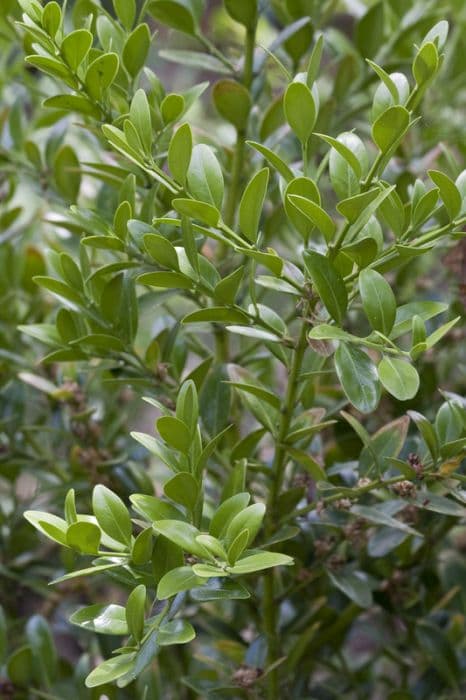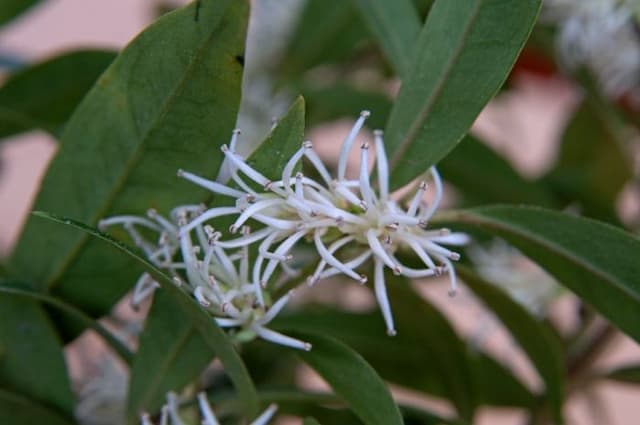Sweet Box Sarcococca hookeriana Winter Gem = 'Pmoore03' (PBR)
![sweet box [Winter Gem]](/_next/image?url=https%3A%2F%2Fplants-admin.emdemapps.com%2Fimages%2Fplants%2F%2Fimages%2F604b6267b442c.png&w=3840&q=75)
ABOUT
Sarcococca hookeriana Winter Gem, commonly known as sweet box, is an evergreen shrub known for its glossy, deep green leaves that are elongated and pointed at the tip, providing a lush appearance year-round. In the cooler months, typically from late winter to early spring, sweet box produces small, white, tubular flowers that are highly fragrant, often filling the surrounding area with a sweet scent. Following the flowering period, this plant may produce black berry-like fruits which persist into the season. The leaves of sweet box are arranged alternately on the stems, which adds to the plant's dense and bushy appearance. This makes the sweet box an attractive option for adding greenery to gardens or used as a low hedge or border planting due to its neat and tidy growth habit. Overall, the sweet box is cherished for its delightful aroma, durable foliage, and modest ornamental qualities.
About this plant
 Names
NamesFamily
Buxaceae.
Synonyms
Sweet Box, Christmas Box, Winter Gem Box.
Common names
Sarcococca hookeriana var. digyna 'Winter Gem'.
 Toxicity
ToxicityTo humans
The Sweet Box (Sarcococca hookeriana 'Winter Gem') is not commonly listed as a poisonous plant to humans. However, even non-toxic plants might cause minor gastrointestinal discomfort if ingested in significant amounts due to the presence of saponins or other irritating compounds. As with many plants, it is advisable to avoid ingesting parts of this plant, and always handle plants with care if you have sensitive skin or known allergies. If ingested and symptoms appear, it is recommended to seek medical advice.
To pets
The Sweet Box (Sarcococca hookeriana 'Winter Gem') is generally not considered toxic to pets. While not specifically listed as poisonous, it is still prudent to prevent pets from ingesting plants. Some pets might experience mild stomach upset if they consume parts of this plant. As with exposure to any plant, if you notice your pet exhibits symptoms like vomiting, diarrhea, or unusual behavior after ingestion, it is wise to consult a veterinarian.
 Characteristics
CharacteristicsLife cycle
Perennials
Foliage type
Evergreen
Color of leaves
Green
Flower color
White
Height
3-4 feet (0.9-1.2 meters)
Spread
3-5 feet (0.9-1.5 meters)
Plant type
Shrub
Hardiness zones
6-9
Native area
Himalayas
Benefits
 General Benefits
General Benefits- Evergreen foliage: Provides year-round greenery and structure to the garden.
- Low maintenance: Requires minimal upkeep once established.
- Fragrant flowers: Produces sweetly scented white flowers, adding sensory appeal to outdoor spaces.
- Drought tolerance: Able to survive periods of low rainfall once fully established.
- Shade tolerance: Grows well in partial to full shade, making it suitable for understory planting and shaded gardens.
- Dense growth habit: Works well as a natural ground cover or for filling in gaps in the landscape.
- Winter interest: Flowers and retains foliage during winter, providing contrast in a typically dormant garden.
- Wildlife friendly: Attracts pollinators such as bees when in flower.
- Compact size: Suitable for small gardens, borders, and containers due to its moderate growth size.
- Easy propagation: Can be propagated from cuttings to create new plants for other areas of the garden or to share.
 Medical Properties
Medical PropertiesThis plant is not used for medical purposes.
 Air-purifying Qualities
Air-purifying QualitiesThis plant is not specifically known for air purifying qualities.
 Other Uses
Other Uses- Natural Insect Repellent: The sweet fragrance of Sarcococca, also known as Sweet Box, can deter certain insects from lingering in the garden area where it is planted.
- Privacy Screening: With its dense, evergreen foliage, Sweet Box can be used to create a low privacy hedge in a garden.
- Aromatherapy: The intense fragrance of Sweet Box flowers can be used in aromatherapy to create a calming and relaxing environment.
- Winter Interest: As an evergreen with wintertime flowers, Sweet Box adds visual interest to gardens during the dreary winter months when other plants are dormant.
- Boundary Marking: The compact growth habit of Sweet Box makes it suitable for marking property lines without the need for fences or walls.
- Erosion Control: Sweet Box's root system can help stabilize soil on slopes and prevent erosion.
- Ground Cover: Sweet Box can be used as ground cover in shady areas where grass and other plants struggle to grow.
- Zen Gardens: Its minimalist appearance and calming aroma make Sweet Box a good addition to Zen or meditation gardens.
- Textural Contrast: Sweet Box can be used in garden design to provide textural contrast with its glossy leaves, especially amongst plants with matte foliage or larger leaves.
- Holiday Decorations: Branches of Sweet Box, with their attractive foliage and berries, may be used for creating natural holiday wreaths and garlands.
Interesting Facts
 Feng Shui
Feng ShuiSweet Box is not used in Feng Shui practice.
 Zodiac Sign Compitability
Zodiac Sign CompitabilitySweet Box is not used in astrology practice.
 Plant Symbolism
Plant Symbolism- Protection: Sarcococca is often associated with protection due to its dense growth habit which can provide a natural barrier against unwanted visitors and negative energies.
- Purity: The pure white flowers of Christmas Box symbolize purity and are considered to bring clean and positive energy to its surroundings.
- Hope: The early flowering of the Christmas Box at the end of winter signifies hope and the promise of spring, rebirth, and renewal.
- Consistency: As an evergreen plant, Christmas Box represents consistency, stability, and the idea of remaining steadfast despite changing conditions.
- Peace: The sweet fragrance of Christmas Box flowers is thought to induce a peaceful atmosphere, hence symbolizing tranquility and calmness.
 Water
WaterThe Sweet Box should be watered moderately, aiming to keep the soil consistently moist without being overly saturated. During the growing season, typically in the spring and summer, water with approximately 1 gallon per week depending on the weather conditions; this amount may need to increase during particularly dry or hot spells. In the fall and winter, reduce the frequency to every other week or when the top inch of soil feels dry to the touch. Avoid letting the plant sit in waterlogged soil as this can lead to root rot. If grown in containers, ensure proper drainage is in place to prevent excess water accumulation.
 Light
LightSweet Box performs best in partial to full shade. It is ideal to plant it in a location where it can be shielded from the harsh afternoon sun to prevent leaf burn. Morning light or dappled sunlight is suitable, making it an excellent choice for understory planting or north-facing gardens where direct sunlight is limited.
 Temperature
TemperatureSweet Box thrives in a temperature range between 60 to 80 degrees Fahrenheit. It is hardy and can withstand minimum temperatures down to around 0 degrees Fahrenheit, allowing it to survive in colder climates. To ensure optimal growth, maintain a position where the plant is not exposed to extreme temperature fluctuations, and shelter from cold winter winds is advantageous.
 Pruning
PruningPruning Sweet Box is beneficial to maintain shape, remove dead or diseased wood, and encourage bushier growth. The best time to prune is in late winter or early spring before new growth begins. Lightly trim the plant to shape it as desired and remove any unwanted branches. This plant doesn't require heavy pruning, so it's often enough to simply cut back what is necessary to maintain its appearance.
 Cleaning
CleaningAs needed
 Soil
SoilSweet Box prefers well-drained, humus-rich soil with a slightly acidic to neutral pH of about 5.5 to 7. Amend the soil with organic matter to improve drainage and nutrient content.
 Repotting
RepottingSweet Box plants generally have a slow growth rate and can go several years without needing to be repotted. Expect to repot them every 3 to 5 years or when they outgrow their current container.
 Humidity & Misting
Humidity & MistingSweet Box thrives in moderate to high humidity levels; however, it is quite adaptable and can tolerate lower humidity conditions commonly found in most home environments.
 Suitable locations
Suitable locationsIndoor
Place Sweet Box in bright, indirect light and keep soil moist.
Outdoor
Plant Sweet Box in partial shade and well-draining soil.
 Life cycle
Life cycleThe life of Sarcococca hookeriana 'Winter Gem', commonly known as Sweet Box or Christmas Box, begins with the germination of seeds in moist, well-drained soil, preferably in shaded conditions. As it enters the seedling stage, the plant develops its root system and first leaves. Growth continues through the juvenile phase where the plant increases in size and begins to form its characteristic evergreen foliage. Upon reaching maturity, which may take several years, 'Winter Gem' blooms in late winter to early spring, producing small, fragrant white flowers that are followed by the development of glossy black berries if pollination occurs. The plant's growth slows down once it reaches maturity, but it will continue to produce new leaves and flowers each season. Over time, without significant disturbance, 'Winter Gem' can live for many years, maintaining a compact, bushy habit and providing year-round interest to gardens.
 Propogation
PropogationPropogation time
Late winter-early spring
The most popular method to propagate Sarcococca hookeriana 'Winter Gem', commonly known as Sweet Box, is by semi-hardwood cuttings. This process should ideally be done in late summer. One would take a cutting of about 4-6 inches (10-15 centimeters) from new growth that has begun to harden, ensuring a few leaves remain on the cutting. The base of the cutting is dipped in rooting hormone powder to accelerate the development of new roots. Then, the cutting is inserted into a well-draining soil mix, ensuring at least two nodes are buried where the leaves were removed. The cutting should be kept under high humidity with bottom heat if possible, and in a few weeks, it should root successfully, ready to be potted on or eventually planted out once established.









